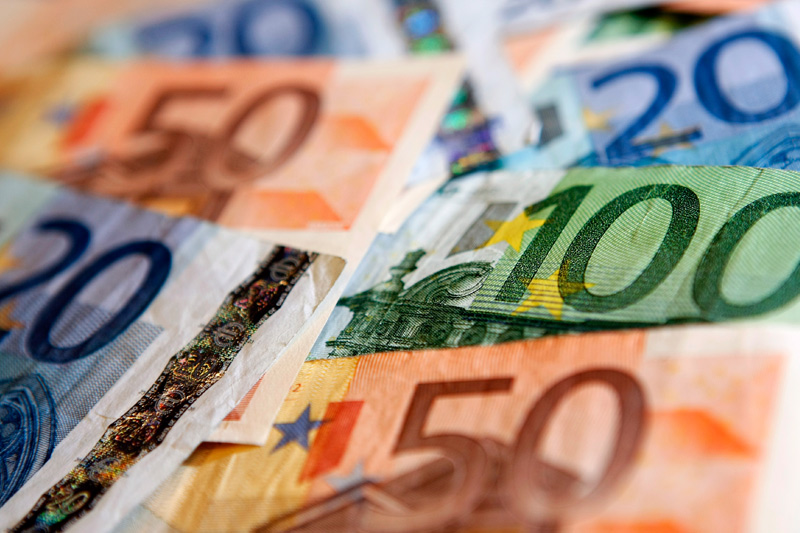Investing.com’s stocks of the week
Investing.com - The euro was mixed to broadly higher against its global counterparts on Wednesday, as market sentiment was boosted by an upbeat start to the first quarter earnings season, but gains looked likely to remain limited amid ongoing concerns over the debt crisis in the euro zone.
During European late morning trade, the euro was higher against the U.S. dollar, with EUR/USD rising 0.47% to hit 1.3143.
Risk appetite was supported after the first quarter earnings season kicked off with a surprise profit from aluminum producer Alcoa.
But the euro remained vulnerable after the yield on Spain’s 10-year government bonds briefly rose to a four month high of 6.01% earlier, amid concerns that the effects of the European Central Bank’s liquidity operation is wearing off.
Spanish Prime Minister Mariano Rajoy was to make a speech on the country’s recent austerity budget later in the day, as investors remained fearful that deficit reduction targets will not be met and the country will need a bailout.
Meanwhile, Italy saw its one-year borrowing costs rise for the first time since November earlier, in a poorly received government bond auction.
The single currency inched higher against sterling, but remained within striking distance of a three-month low, with EUR/GBP easing up 0.08% to hit 0.8254.
In the U.K., a report showed that British retail sales rose at their fastest pace so far this year last month, fuelling hopes that the economic recovery is gaining traction.
The British Retail Consortium said like-for-like retail sales rose at an annualized rate of 1.3%, after declining by 0.3% in February.
The euro was up against the yen, with EUR/JPY adding 0.66% to hit 106.23.
Earlier Wednesday, Japan’s finance minister said he was watching the yen’s movements with “great interest” after the currency hit a six-week high against the dollar earlier, as concerns over the euro zone bolstered safe haven demand.
The euro was little changed against the Swiss franc, with EUR/CHF dipping 0.02% to hit 1.2013.
The shared currency was mixed against the Canadian, Australian and New Zealand dollars, with EUR/CAD gaining 0.25% to hit 1.3169, EUR/AUD easing down 0.08% to hit 1.2751 and EUR/NZD dipping 0.06% to hit 1.6040.
Official data showed earlier that home loans in Australia fell less-than-expected in February, ticking down 2.5% after a 1.1% decline the previous month.
Analysts had expected home loans to drop 3.6% in February.
The data came after a report by the Westpac Banking Corporation showed that Australian consumer sentiment for April declined 1.6%, following a 5.0% fall the previous month.
Later in the day, the U.S. was to release official data on import prices and crude oil stockpiles, as well as a report on the federal budget balance. The Federal Reserve was also to publish its Beige Book.
During European late morning trade, the euro was higher against the U.S. dollar, with EUR/USD rising 0.47% to hit 1.3143.
Risk appetite was supported after the first quarter earnings season kicked off with a surprise profit from aluminum producer Alcoa.
But the euro remained vulnerable after the yield on Spain’s 10-year government bonds briefly rose to a four month high of 6.01% earlier, amid concerns that the effects of the European Central Bank’s liquidity operation is wearing off.
Spanish Prime Minister Mariano Rajoy was to make a speech on the country’s recent austerity budget later in the day, as investors remained fearful that deficit reduction targets will not be met and the country will need a bailout.
Meanwhile, Italy saw its one-year borrowing costs rise for the first time since November earlier, in a poorly received government bond auction.
The single currency inched higher against sterling, but remained within striking distance of a three-month low, with EUR/GBP easing up 0.08% to hit 0.8254.
In the U.K., a report showed that British retail sales rose at their fastest pace so far this year last month, fuelling hopes that the economic recovery is gaining traction.
The British Retail Consortium said like-for-like retail sales rose at an annualized rate of 1.3%, after declining by 0.3% in February.
The euro was up against the yen, with EUR/JPY adding 0.66% to hit 106.23.
Earlier Wednesday, Japan’s finance minister said he was watching the yen’s movements with “great interest” after the currency hit a six-week high against the dollar earlier, as concerns over the euro zone bolstered safe haven demand.
The euro was little changed against the Swiss franc, with EUR/CHF dipping 0.02% to hit 1.2013.
The shared currency was mixed against the Canadian, Australian and New Zealand dollars, with EUR/CAD gaining 0.25% to hit 1.3169, EUR/AUD easing down 0.08% to hit 1.2751 and EUR/NZD dipping 0.06% to hit 1.6040.
Official data showed earlier that home loans in Australia fell less-than-expected in February, ticking down 2.5% after a 1.1% decline the previous month.
Analysts had expected home loans to drop 3.6% in February.
The data came after a report by the Westpac Banking Corporation showed that Australian consumer sentiment for April declined 1.6%, following a 5.0% fall the previous month.
Later in the day, the U.S. was to release official data on import prices and crude oil stockpiles, as well as a report on the federal budget balance. The Federal Reserve was also to publish its Beige Book.
